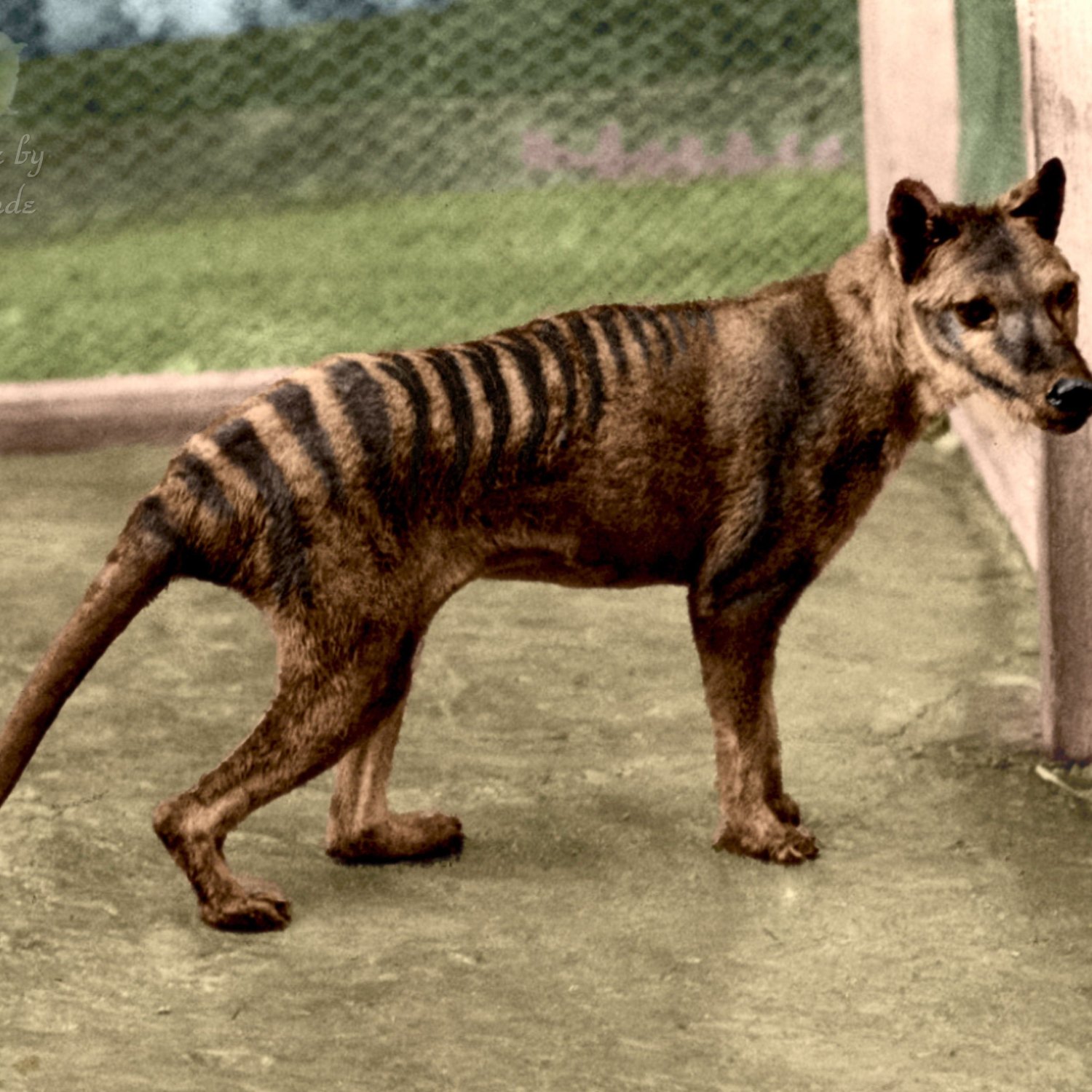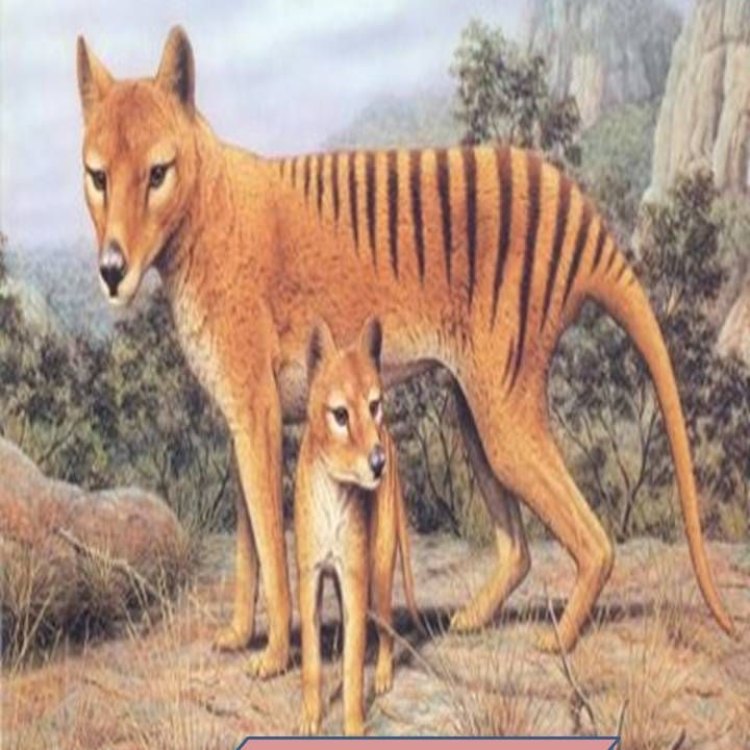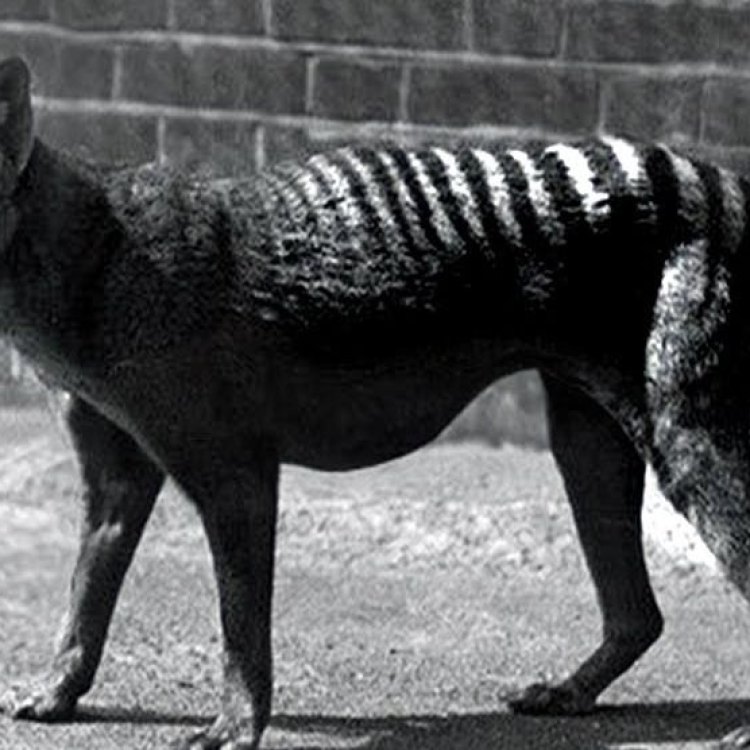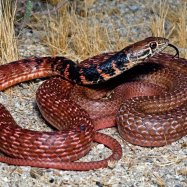
Tasmanian Tiger
100-130 cm
The Tasmanian Tiger, also known as the Thylacine, is a dog-like marsupial that was native to Tasmania. Unfortunately, the last known Tasmanian Tiger died in captivity in 1936, making it the first recorded species to become extinct due to humans. Its length ranged from 100-130 cm and it belonged to the Thylacinidae family. Despite its name, the Tasmanian Tiger was not actually a tiger, but rather a marsupial with striped markings resembling a tiger. Let's work together to prevent the extinction of more unique animals like the Tasmanian Tiger. #SavetheThylacine #AnimalConservation
Animal Details Summary:
Common Name: Tasmanian Tiger
Kingdom: Animalia
Habitat: Grasslands, forests, and wetlands
The Tragic Tale of the Tasmanian Tiger: A Lost Species of Australia
In the forests, grasslands, and wetlands of Tasmania, Australia, once lived a unique and fascinating creature known as the Tasmanian Tiger. Its scientific name was Thylacinus cynocephalus, but it was more commonly known as the Tasmanian Tiger due to its striped appearance resembling that of a tiger. This elusive animal has a rich and heartbreaking history that has captured the attention and curiosity of many.The Tasmanian Tiger was a member of the Animalia kingdom, Chordata phylum, Mammalia class, and Dasyuromorphia order Tasmanian Tiger. It belonged to the Thylacinidae family, which is characterized by carnivorous mammals with dog-like features. This intriguing species was once found in abundance throughout Tasmania, but sadly, it is now considered extinct.
The Tasmanian Tiger's habitat included various environments such as forests, grasslands, and wetlands. They were adaptable creatures, able to thrive in different landscapes, making them highly successful hunters. They were carnivorous, feeding on small animals such as birds, kangaroos, wallabies, and even sheep. Their striking yellowish-brown fur, highlighted with dark stripes, made them well-camouflaged predators.
This beautiful creature was native to Australia, with its only known location being Tasmania. The island state of Tasmania, located off the coast of southeastern Australia, was a sanctuary for the Tasmanian Tiger. It provided the perfect environment for them to live and thrive, away from human interference Thylacoleo.
The Tasmanian Tiger was a dog-like animal, with an average length of 100-130 cm and a body shape similar to that of a canine. Their most distinctive feature was their long and thin tail, which was about the same length as their body. This tail served as a balancing tool, allowing them to quickly change direction while chasing their prey.
Despite their impressive appearance and unique features, the Tasmanian Tiger was no match for human actions. The arrival of Europeans in Australia signaled the beginning of the Tasmanian Tiger's tragic demise. The early Europeans viewed the species as a threat to their livestock and economic interests and began a relentless campaign to eliminate them.
In 1805, the first recorded Tasmanian Tiger was killed, and it marked the beginning of mass extermination. The Tasmanian Tiger was hunted ruthlessly, and many were poisoned, trapped, and shot. The government even offered bounties for each Tasmanian Tiger killed, further fueling the massacre of these intriguing creatures.
As the Tasmanian Tiger's numbers declined, the Tasmanian government finally decided to intervene in 1888 and declared the species as protected. However, it was too little too late. By then, the Tasmanian Tiger had become a rare sight, with only a few scattered in remote areas of the island.
The Tasmanian Tiger's dwindling numbers were not the only threat facing the species. The introduction of diseases such as distemper and mange by European dogs also contributed to their decline. Inbreeding due to a small population and habitat destruction also played a significant role in their extinction.
The saddest chapter in the Tasmanian Tiger's history began in the early 1900s. The last known living Tasmanian Tiger, called Benjamin, was captured in the Florentine Valley in Tasmania in 1933. He was then transferred to the Hobart Zoo, where he lived the remainder of his days. Benjamin was a tourist attraction at the zoo, and many people traveled from far and wide to catch a glimpse of this curious creature.
However, despite being protected in the zoo, Benjamin's life came to a tragic end on September 7, 1936. In a cruel twist of fate, he was locked out of his shelter, exposed to the freezing weather, and died from exposure. The death of Benjamin marked the end of the Tasmanian Tiger, with the species being declared officially extinct in 1986.
The Tasmanian Tiger's extinction is considered one of the world's biggest animal extinctions caused by human interference. It is an unfortunate lesson on the devastating impact of human actions on wildlife. However, despite its extinction, the Tasmanian Tiger remains a significant icon in Australia, with its image featuring on the country's official coat of arms.
Today, the Tasmanian Tiger holds a special place in the hearts of Australians, and its legacy continues to live on. Many organizations and researchers are still searching for any signs of a surviving population, but none have been found so far. There have been several alleged sightings of the Tasmanian Tiger over the years, but none have been confirmed.
Efforts to clone the Tasmanian Tiger have also been ongoing, with numerous genetic samples being collected and preserved. However, this has faced significant challenges as the samples collected are often too degraded to provide viable DNA for cloning.
Despite its extinction, the Tasmanian Tiger continues to captivate the minds of many, and its image remains a significant part of Australia's cultural identity. The tragedy of its extinction serves as a sobering reminder of the need to protect and preserve our planet's precious and unique species.
In conclusion, the Tasmanian Tiger was a fascinating and unique creature that once roamed the forests, grasslands, and wetlands of Tasmania, Australia. Its striking appearance, dog-like features, and incredible hunting capabilities made it a top predator in its environment. However, human actions and interference ultimately led to its demise, making the Tasmanian Tiger one of the world's biggest animal extinctions. Today, the Tasmanian Tiger serves as a reminder of the fragile nature of our planet's wildlife and the impacts of human actions on their survival. Let us learn from this tragedy and work towards preserving and protecting the diverse and beautiful species that share our planet.

Tasmanian Tiger
Animal Details Tasmanian Tiger - Scientific Name: Thylacinus cynocephalus
- Category: Animals T
- Scientific Name: Thylacinus cynocephalus
- Common Name: Tasmanian Tiger
- Kingdom: Animalia
- Phylum: Chordata
- Class: Mammalia
- Order: Dasyuromorphia
- Family: Thylacinidae
- Habitat: Grasslands, forests, and wetlands
- Feeding Method: Carnivorous
- Geographical Distribution: Tasmania, Australia
- Country of Origin: Australia
- Location: Tasmania
- Animal Coloration: Yellowish-brown with dark stripes
- Body Shape: Dog-like
- Length: 100-130 cm

Tasmanian Tiger
- Adult Size: Around 60-75 cm at the shoulder
- Average Lifespan: Up to 7 years
- Reproduction: Sexual
- Reproductive Behavior: Mating season in winter
- Sound or Call: Yelps and growls
- Migration Pattern: Non-migratory
- Social Groups: Solitary or in small family groups
- Behavior: Nocturnal and crepuscular
- Threats: Habitat loss and hunting
- Conservation Status: Extinct
- Impact on Ecosystem: Unknown
- Human Use: Hunted for its fur
- Distinctive Features: Striped back and stiff kangaroo-like tail
- Interesting Facts: The Tasmanian Tiger is not a tiger but a marsupial carnivore. It was also known as the thylacine. The last known individual died in captivity in 1936.
- Predator: Extinct

Thylacinus cynocephalus
The Elusive Tasmanian Tiger: From Mysterious Beast to Extinction
The Tasmanian Tiger, also known as the thylacine, was once a prominent and elusive creature in the Australian wilderness. Its distinctive appearance, behavior, and tragic demise have captivated the minds of many for centuries. Despite its name, the Tasmanian Tiger was not a tiger at all, but a unique marsupial carnivore that inhabited the island of Tasmania. Today, it is a reminder of the impact human activity can have on the delicate balance of nature PeaceOfAnimals.Com.Adult Tasmanian Tigers were around 60-75 cm tall at the shoulder and weighed up to 30kg. They had a slim and muscular build, with a distinctive striped back that gave them the appearance of a large cat. The most recognizable feature of the Tasmanian Tiger was its stiff and kangaroo-like tail, which was used for balance and stability while hunting and running.
These mysterious creatures had an average lifespan of up to 7 years in the wild. However, their reproductive patterns were quite unique compared to other animals. They were sexually reproducing, with a mating season that occurred during the winter months. During this time, the males would compete for the females' attention through yelps and growls. Once a female was impregnated, she would give birth to around 2-4 young, which she would carry in her pouch until they were old enough to survive on their own.
The Tasmanian Tiger was primarily a nocturnal and crepuscular animal, meaning they were most active during the night and at dawn and dusk Tiger Salamander. These times were ideal for hunting and avoiding predators. Their diet consisted mainly of small mammals such as wallabies and possums, but they were also known to scavenge for food. Their powerful jaws and sharp teeth made them formidable predators, and their striped camouflage helped them blend into their surroundings.
While Tasmanian Tigers were not migratory, they did have a wide range of habitats, from dense forests to open grasslands. They were found all over Tasmania and even on the Australian mainland until the 1800s. However, their population began to decline rapidly due to human activities such as habitat loss and hunting.
The arrival of European settlers in the 19th century brought about significant changes to the Tasmanian Tiger's habitat. Their natural prey, such as kangaroos and wallabies, were hunted for food, resulting in a decrease in the Tasmanian Tiger's food sources. Moreover, human settlement and agriculture led to deforestation, which further reduced their habitat and food sources.
As the Tasmanian Tiger's population dwindled, hunting them became a popular sport and a means to protect livestock. This accelerated their decline, and by the early 1900s, they were considered a pest and a threat to farmers. Government bounties were put in place, and they were hunted and killed in large numbers. The last known individual died in captivity in 1936, and with its death, the Tasmanian Tiger was declared extinct.
Today, the Tasmanian Tiger's extinction remains one of the most significant and controversial incidents in Australian history. Despite numerous reported sightings over the decades, there is no conclusive evidence to prove that they still exist. The Tasmanian government has even offered a cash reward for proof of their continued existence or evidence of their extinction.
The extinction of the Tasmanian Tiger has had a profound impact on the ecosystem of Tasmania. As apex predators, they played a crucial role in maintaining the balance of species in their environment. With their disappearance, there has been a domino effect on the ecosystem, but the extent of their impact is still unknown. Some scientists believe that their absence may have contributed to an increase in the population of invasive species such as foxes and feral cats, leading to further harm to the native flora and fauna.
While the Tasmanian Tiger's extinction is a tragedy in itself, it is also a reminder of our responsibility as humans to protect and preserve our natural world. The devastating impact of human activity on these animals is a harsh lesson for us to learn from. The loss of this unique creature also highlights the importance of conservation efforts and the need to protect endangered species.
What is perhaps most intriguing about the Tasmanian Tiger is the mystery surrounding its existence. Despite its classification as extinct, there are still reports of sightings and claims of its survival. There have been numerous expeditions and searches for physical evidence, such as DNA samples, but none have been conclusive. This ongoing mystery keeps the Tasmanian Tiger alive in our minds and our imaginations.
In conclusion, the Tasmanian Tiger, also known as the thylacine, was once a fascinating and elusive creature that roamed the Australian wilderness. Its distinctive features, unique behavior, and tragic fate have captured the hearts and minds of many. Its extinction serves as a poignant reminder of the impact of human activity on our environment and the need for conservation efforts. The quest for proof of the Tasmanian Tiger's continued existence continues, but its legacy will live on as a reminder of the fragile balance of nature and our role in preserving it.

The Tragic Tale of the Tasmanian Tiger: A Lost Species of Australia
Disclaimer: The content provided is for informational purposes only. We cannot guarantee the accuracy of the information on this page 100%. All information provided here may change without prior notice.












